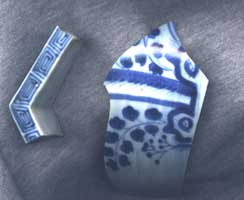After several weeks of becoming more familiar with the Market Street Chinatown collection, and training in artifact identification and analysis, we are now turning our efforts to individual student projects. The students enrolled in this class are required to complete a research project utilizing artifacts recovered from the Market Street Chinatown, using the skills they have learned and a mix of their own research interests and the great questions that have been posed by members of the Chinese Historical and Cultural Project as well as visitors to the Open House. Earlier this week, students turned in their research designs, which detailed their plans for research. The photo on the right is of a Four Flowers condiment dish that has had a Chinese character pecked into it. One of the students in this class is working together with members of the Bay Area Chinese community and with a Stanford student to translate these characters. She is interested in understanding what part of the site ceramics with pecked characters on them came from, in order to consider why characters were pecked into vessels – were these marks of ownership, wishes for good luck, or what? Vessels with pecked characters are not uncommon at overseas Chinese sites, but the Market Street collection has a rather high number of such vessels – at least 15 in the part of the collection we are currently working with. The pecked character shown here translates as “Drunk”, and was found in a wood-lined pit associated with a single story tenement building.
Another project will address questions about the quality of life in the Market Street Chinatown, in comparison to the Woolen Mills Chinatown. The student undertaking this project will be looking at different designs and patterns on Chinese export porcelain bowls in order to make an index of the relative economic values of the ceramics at each site. Another student plans to expand questions about quality of life issues to a consideration of medicines and health practices at the Market Street and Woolen Mills Chinatowns. Both of these students will be relying on the excavation reports from the Woolen Mills Chinatown in order to make these comparisons. This is exciting in that it ties the two sites together, and helps build toward an understanding of the Chinese Community in San Jose over time and at multiple sites. These projects will shed light on some of the differences between a bachelor community and one with a more mixed population. Another student intends to look at activities and practices related to pleasure at the Market Street Chinatown. He will begin with the opium pipe bowl pictured here, and then will expand his analysis from this single object to other artifacts associated with pleasure that were found in the same archaeological feature, and then from this feature to the site as a whole. Please check back in about a month, as the student projects will be posted on this website.
Artifact of the Week
This week’s artifacts of the week are more examples of artifacts that have us stumped. First, let us share with you what we do know. The artifact on the left (85-31/28-44) is a rim fragment of a hexagonal dish, decorated with a hand-painted blue-on-white pattern. The artifact on the right (85-31/13-18) is a body sherd from a large bowl, also hand-painted in a blue-on-white pattern. While we have been able to identify the vessel forms and fabrics, we are unsure about the patterns of the decoration. The decoration on these two artifacts strongly resembles the decoration on Chinese export porcelains, porcelains made in China primarily for markets outside the country, particularly in Europe, North America, and their colonies. However, a search of sources on Chinese export porcelains did not lead to a positive identification of the decorative pattern on either artifact. We are hoping that a visitor to this website may be able to help us! If you recognize either pattern, or could suggest resources for us to check or patterns which are similar, we would greatly appreciate it!


